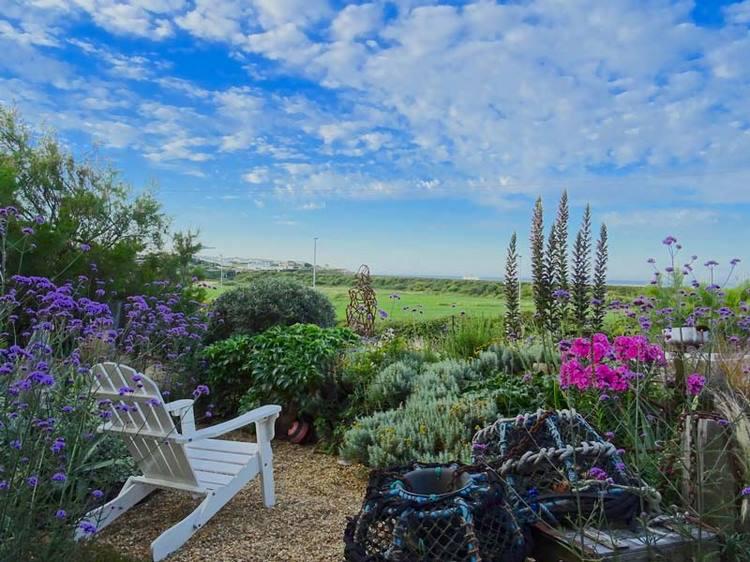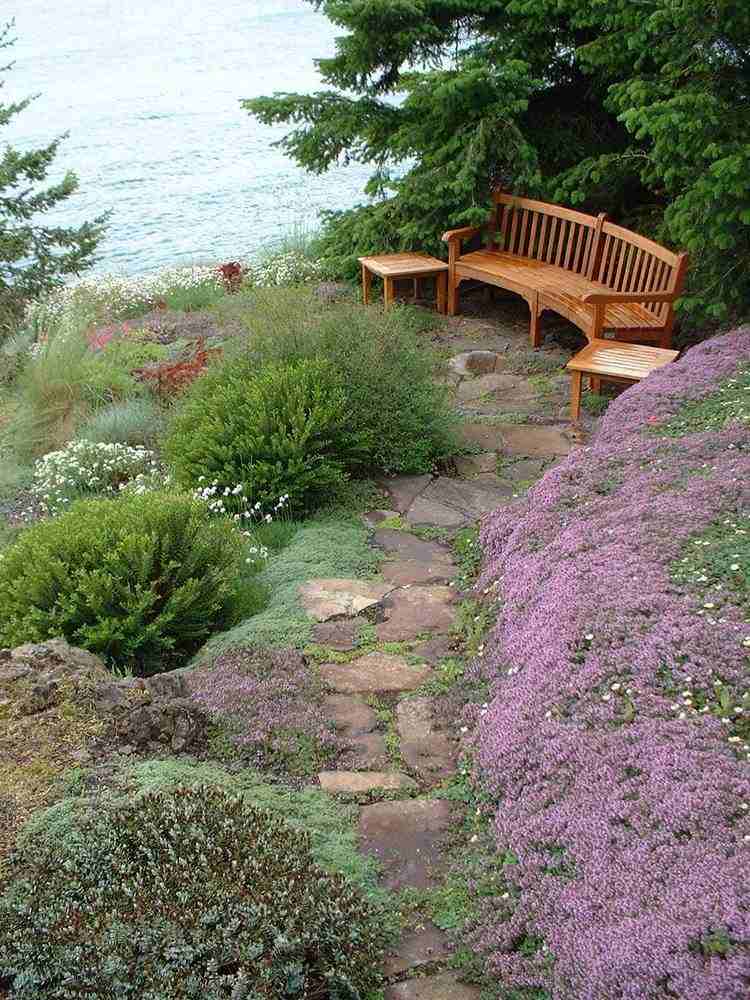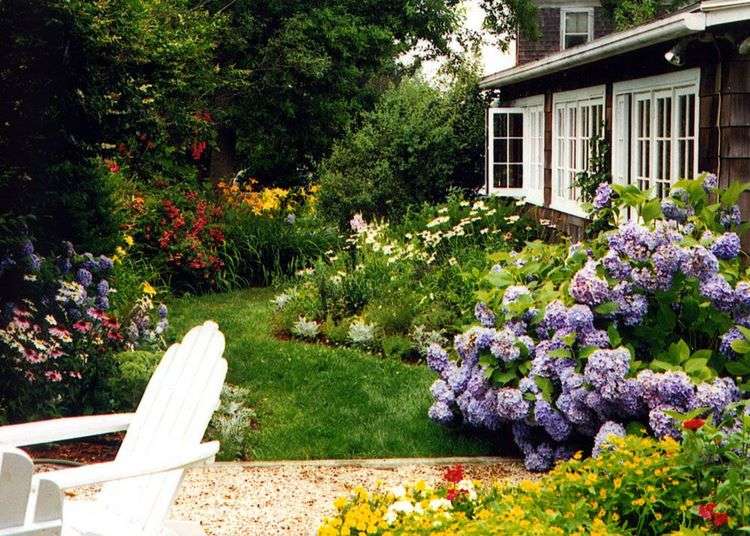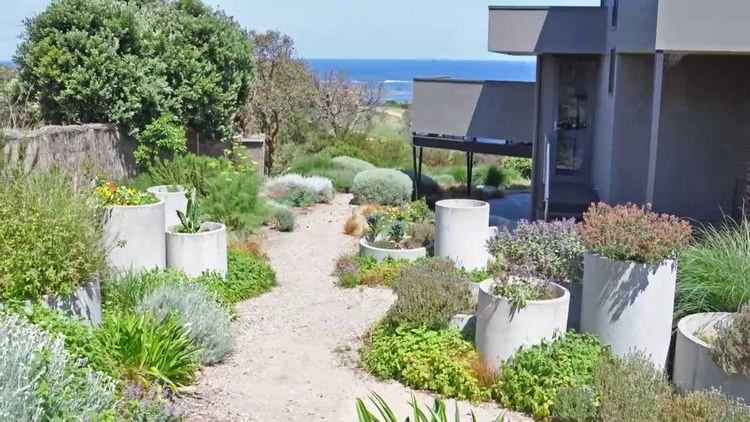When it comes to coastal garden design ideas, it is usually a seaside terrain. Coastal regions are distinguished by a very warm, sometimes even hot and dry climate and a specific flora. However, coastal gardens are often set up in regions with more severe weather conditions – for example, in Scotland on the shores of the English Channel, exotic plants such as palm trees may grow well.
The proximity of the sea has its pros and cons, so an individual approach is required in each case. The main disadvantage, as a rule, is rather strong winds blowing from the sea, and the salt content in the air as it may be fatal for some plants. On the other hand, the proximity of water makes the climate milder, especially in winter, so the temperature drops do not have a negative effect on plants.
In general, if you plan the landscape design properly and provide the plants with protection from the wind, you can grow quite capricious species in coastal gardens. It is not necessary to erect tall walls around the garden plot that will act as a wind shield. Planting trees and large shrubs, mainly evergreens, does an excellent job as they will protect the garden from the wind, they will not block the view of the sea and will not violate the natural harmony.
Coastal garden design ideas – proper planning is essential
Many people are fascinated by coastal garden design ideas, especially by the romantic Mediterranean style landscapes with climbing plants, aromatic herbs, arches, gazebos and water features. If you are one of those people, let’s see how you can create a magnificent coastal garden in your backyard.
When you start planning your exterior design, you need to know what the key features of seaside gardens are. For example:
- Easy Maintenance
- All weather surfaces
- Shelter and Shade
- Lighting
- Space for al-fresco dining
- Water features
- Robust and hardy planting
- Great views
It is especially important to consider the location of your plot and the conditions as they will affect the plant species. Winds will naturally have a greater impact on a garden located almost on the coastline than on an area located farther from the sea. Strong winds will limit the choice of species that you can plant, and in such cases you can focus on the architectural elements of a coastal garden design – cobbled areas, courtyards, paths, etc. Of course, this does not mean that there will be no vegetation in the garden at all – you just have to limit yourself to lawns and the most hardy and unpretentious species. Delicate specimens are usually planted in containers, hanging baskets and pots and, if necessary, the plants can be brought indoors, placed under a canopy or against a wall.
Another challenging factor that you need to keep in mind is the fact that the soil in coastal gardens usually dry, sandy or stony, which means that it does not retain moisture for long after watering or rain. This means that you will need dry-loving plant species.
A variety of materials are used for paving courtyards and paths – stone, brick, decorative tiles, sandstone, wood, pavers, etc. The gaps between the slabs are filled with drought-resistant grasses.
Shade and shelter – these are important elements in a coastal garden design if you want to stay outdoors as much as possible. There are many options – pergolas, gazebos, pavilions – which will protect you from sun’s rays during the day and the wind at night.
Garden lighting is essential and you need to plan it in advance. Whether you prefer bright lights or subtle, romantic lighting, make sure it is installed prior planting.
If you have a sea view and you can hear the sound of the waves, you are really lucky. However, if you are farther from the shoreline, a water feature, small pond or pool will look very impressive in the garden.
Last, but not least, you need to choose your coastal garden style. Mediterranean, tropical, Cape cod, Gravel and rock, Cottage garden – each one has its specific features. For example, Mediterranean gardens are rich in bright colors- orange, golden, nautical blues, white, red, purple and green. You can choose a theme – nautical décor, beach and seashore, Provence, Italy, island oasis, rock garden, etc.
Plants for coastal gardens – trees, shrubs, succulents and flowers
The choice of plants for coastal gardens will depend on the location of the plot, the local climate, the style, and of course, the personal preferences of the homeowners. Brightly colored plants in flower beds are ideal for vibrant coastal gardens and they bring a pop of color to the space. If you prefer low maintenance plants, choose hardy perennials that require minimal care and attention. For example these are the plants that grow on the dunes. Usually they are low height with waxy coating which protects them from the salty sea air.
Trees, shrubs and hedge plants for coastal garden
To protect the coastal garden from bad weather, trees and shrubs that are resistant to sea winds are planted along its border. Usually these are coniferous species. Planted in a dense row, they serve as a very effective barrier and create shade and seclusion. Here are some of the species:
- Ppine (Pinus nigra)
- Monterey cypress (Cupressus macrocarpa)
- European larch (Larix decidua)
- Cordyline
- Holly
- Arbutus
- Pinus mugo
- Hornbeam
- Thuja
- Maritime pine (Pinus pinaster)
- Turkey oak (Quercus laevis)
Shrubs and hedge plants planted between the trees provide protection from the wind at the lower level.
- Puka (Griselinia lucida)
- Firethorn (Pyracantha Coccinea)
- Berberis (Berberis Vulgaris)
- Elaeagnus (Elaeagnus angustifolia)
- Euonymus (Euonymus fortune)
- Escallonia
- Pittosporum (Pittosporum tobira)
- Ribes
- Spiraea
- Phormium
- Hibiscus
- Forsythia
- Lonicera nitida
- Yew
- Beech
- Hawthorn
- Fuchsia
Shrubs and hedge plants add visual interest to the coastal garden, diversify the floristic composition, serve as a living wall and enhance the feeling of privacy. It is best if trees and shrubs are planted as soon as the garden is laid. Of course, it will take them more than one year to become adults and begin to fulfill their protective function but once they grow, you will be able to plant more capricious plants in the garden.
Herbs and perennials for coastal gardens
Rosemary, thyme, oregano and sage are the typical herbs for Mediterranean style coastal gardens. They do very well in hot, dry conditions and due to the fact that they are hardy, you will enjoy their aroma all season long. In addition, you will have fresh herbs for cooking year after year. Basil (Ocimum basilicum), Chive (Allium schoenoprasum), Coriander (Coriandrum sativum), Lavender (Lavandula spp), Marjoram (Origanum majorana) are also suitable.
Perennials will make fantastic borders and add color to your coastal garden. Any of those – Achillea, Crocosmia, Echinops, Erysimum, Euphorbia, Granium, Kniphofia, Rudbeckia, Leucanthemum, Sedum, Verbena are ideal for sunny and bright plots.
Climbing plants for coastal gardens
Climbing plants, as a rule, are planted near vertical surfaces that can become a support for them. Since strong winds blow from the sea, and the stems of the vines are rather fragile, they must be tied to a net or lattice. For the most part, these plants need careful care, especially regular watering and feeding. Some of the climbers that tolerate coastal locations are:
- Chocolate vine (Akebia quinata)
- Trumpet creeper /Trumpet vine (Campsis radicans)
- Common hop (Humulus lupulus)
- Everlasting pea/ Perennial Sweet Pea (Lathyrus latifolius)
- Honeysuckle (Lonicera spp.)
- Angel vine/ Maidenhair Vine (Muehlenbeckia complexa)
- Passion flower (Passiflora caerulea)
Rock garden plants for coastal gardens
Those, who own a rocky plot, can choose rock or gravel plants for coastal gardens. These are ideal to cascade over retaining walls or in gravel garden borders For example:
- Erigeron (Erigeron speciosus)
- Ophiopogon (Ophiopogon planiscapus)
- Aubrieta (Aubrieta hybrida)
- Saxifraga (Saxifraga X arendsii)
- Diascia
- Ceratostigma (Ceratostigma Willmottianum)
- Allium (Ornamental onion)


















